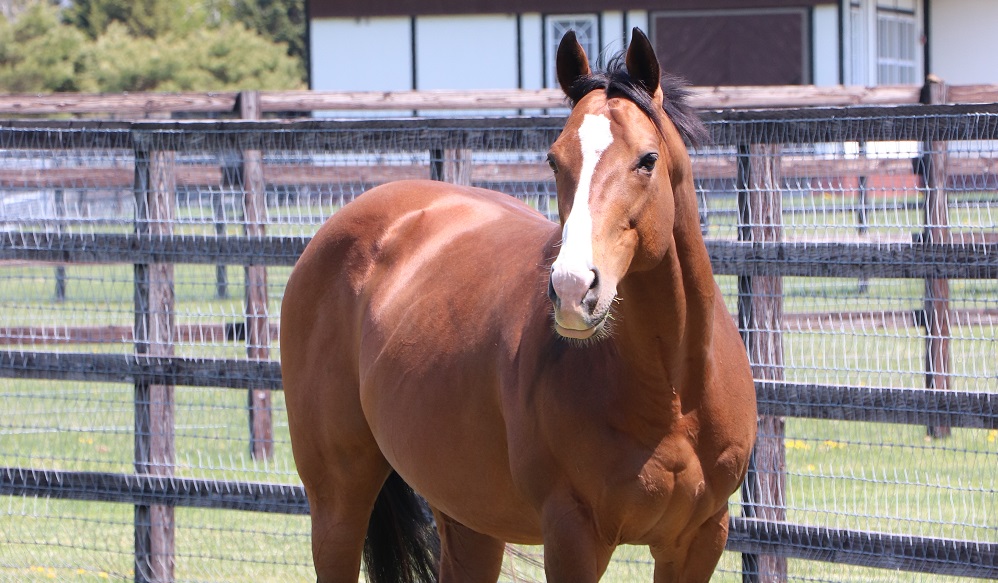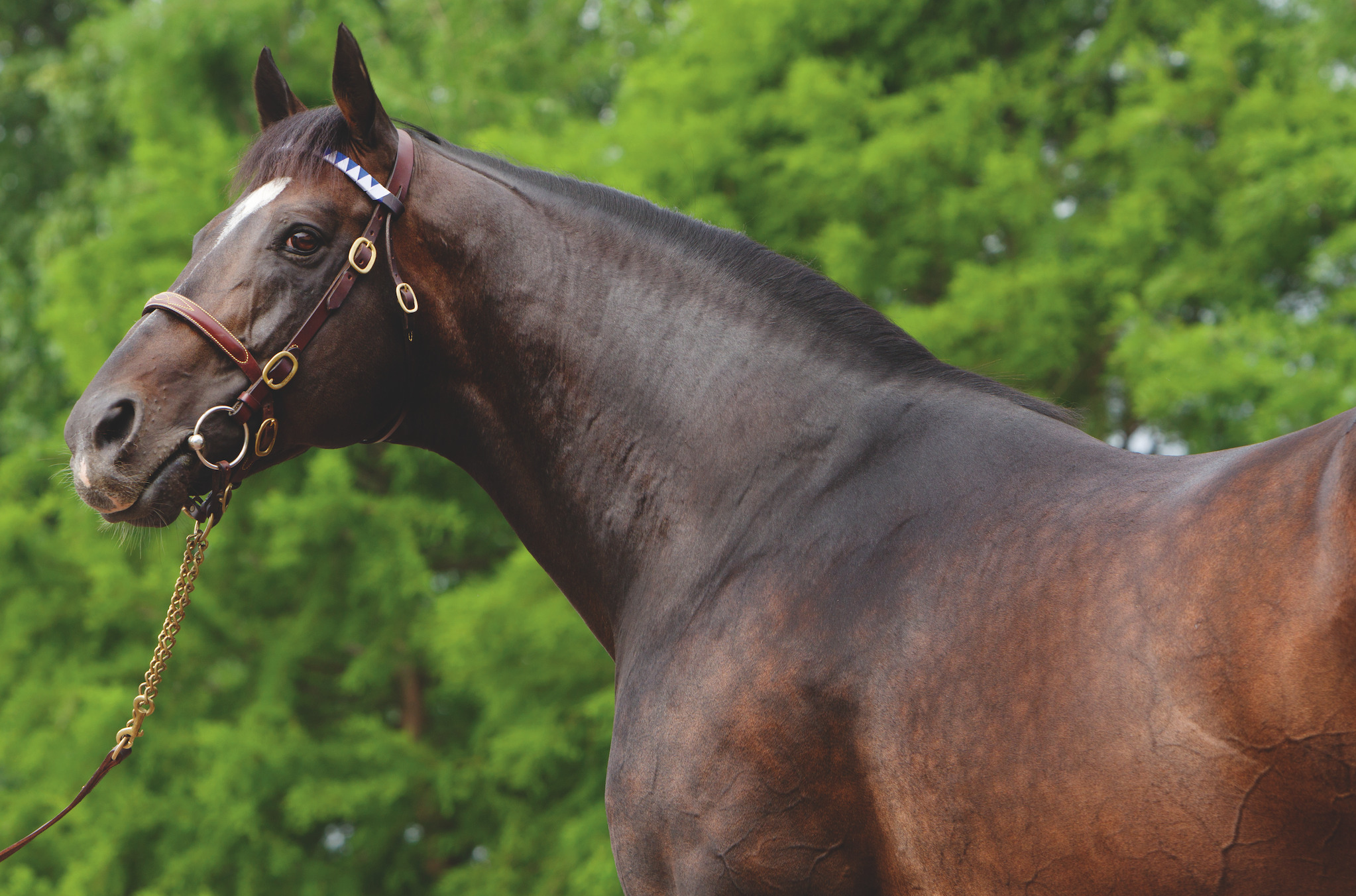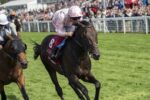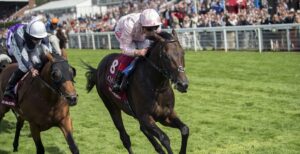Since Aidan O’Brien sent out his first Group 1 winner for the Coolmore partners in 1996, both he and his employers have tried desperately to persuade the breeding world – and perhaps themselves – that outstanding European turf horses can compete with top American dirt performers. The hugely prestigious Breeders’ Cup Classic has been the main target of their ambitions.
And why not? Prior to O’Briens’s appointment, we had seen Andre Fabre land the 1993 Classic with Arcangues, and there had also been honourable efforts by Paul Cole’s British-bred Ibn Bey (a length second to Unbridled in 1990) and by Fabre’s Classic-winning filly Jolypha (third behind A.P. Indy and Pleasant Tap in 1992). The 1998 Classic also saw a fine effort by a European horse, when Saeed bin Suroor’s Swain finished a close third behind Awesome Again and Silver Charm after swerving sharply across the track under a vigorous Frankie Dettori ride.
O’Brien’s first attempt at winning the Classic in 2000 also featured a highly honourable defeat, when Giant’s Causeway failed by only a neck to prevent Tiznow gaining the first of his two victories in the race. There have since been other bold efforts by O’Brien trainees, such as Henrythenavigator’s second to fellow European raider Raven’s Pass in an all-weather edition of the Classic in 2008 and Declaration Of War’s close third behind Mucho Macho Man in 2013. However, there have also been unplaced efforts by horses of the calibre of Hawk Wing, Hold That Tiger, Oratorio, Duke Of Marmalade and So You Think.
This might seem a little strange in view of the fact that Sadler’s Wells was bred in America and that Galileo’s broodmare sire, the Mr Prospector horse Miswaki, had racked up two wins and three seconds from six starts on dirt after his transfer from France
Arguably the biggest disappointments, though, have come when the Coolmore team have tried to prove that the Sadler’s Wells male line has a future on dirt. Galileo finished out of the first two for the only time in his career when sixth of 13, beaten nearly eight lengths by Tiznow, in 2001. Since then we’ve seen his sons Rip Van Winkle, Gleneagles and Churchill all finish towards the rear in the Classic, all beaten by at least 17 lengths in their disappointing ventures off turf.
This might seem a little strange in view of the fact that Sadler’s Wells was bred in America and that Galileo’s broodmare sire, the Mr Prospector horse Miswaki, had racked up two wins and three seconds from six starts on dirt after his transfer from France. Coincidentally, Miswaki’s achievements as a stallion included siring the 1991 Breeders’ Cup Classic winner Black Tie Affair.
Gleneagles and Churchill could also have been expected to do better than they did on Breeders’ Cup day, as both are out of mares by Storm Cat. This grandson of Northern Dancer was responsible for as many as five winners of Breeders’ Cup races on dirt, including the 1999 Classic winner Cat Thief, and he also went close to landing the Classic with Giant’s Causeway, a brother to Gleneagles’ dam You’resothrilling.
Storm Cat still ranks among the most prolific sires of Breeders’ Cup winners, on a list headed by Tapit, Into Mischief and More Than Ready, who have each sired seven. Galileo has made ample amends for his own failure on Breeders’ Cup day, siring a total of six winners, eight seconds and five thirds, but his six winners – Red Rocks, Magician, Found, Highland Reel, Line Of Duty and Tuesday – were all successful on turf.
Galileo’s sire Sadler’s Wells was also responsible for the winners of six Breeders’ Cup races on turf, his scorers being In The Wings, Barathea, Northern Spur, the dual winner High Chaparral and Islington.
That was by no means the full extent of the North American success enjoyed by Sadler’s Wells’ progeny, which extended to at least 30 Graded/Listed winners. Among them were a further eight Grade 1 winners, in the shape of Beat Hollow (Turf Classic, Manhattan Handicap and Arlington Million), French Glory (Rothman’s International), Insight (E.P. Taylor Stakes), Subtle Power (Gulfstream Park Handicap), Ballingarry (Canadian International), Sligo Bay (Hollywood Turf Cup), Perfect Soul (Shadwell Keeneland Turf Mile) and Powerscourt (Arlington Million). There wasn’t a dirt horse among these 30 black- type winners.
This might seem a very lopsided record for an American-bred horse like Sadler’s Wells. Both of his parents, Northern Dancer and Fairy Bridge, were also bred in North America, and all four of his grandparents – Nearctic, Natalma, Bold Reason and Special – were foaled there. However, Nearctic was imported in utero from Europe, as might be guessed from the fact that he was sired by Nearco from Hyperion’s daughter Lady Angela. This means that the top quarter of Sadler’s Wells’s pedigree was European. The other three-quarters also contains several other imported horses, including the brilliant Argentinean horse Forli, who was of European descent; the Derby winner Mahmoud; the Irish-bred Turn-To, who was to sire Hail To Reason; the Eclipse and Champion Stakes winner Djeddah; and the exceptional broodmare Rough Shod, who was a 3,500gns buy at the 1951 Newmarket December Sales.
The perception that most American racehorses of the 1950s, ’60s and ’70s were purely dirt performers is understandable but not totally accurate. For example, Nearctic won at least once on turf and Northern Dancer was successful in the Summer Stakes over a mile on soft turf on his third start at two.
Sadler’s Wells’ broodmare sire Bold Reason was proficient enough on dirt to finish third in both the Kentucky Derby and Belmont Stakes but he also ventured onto turf several times, with the 9.5- furlong Lexington Handicap and the nine-furlong American Derby among his victories. His Claiborne-bred daughter Fairy Bridge carried Robert Sangster’s colours with distinction during a
very brief career which saw her earn a Timeform rating of 115 after winning over five and six furlongs at Phoenix Park. Fairy Bridge’s broodmare sire, Forli, Unlikely source key in US success of Sadler’s Wells Bloodstock world views divided his time between dirt and turf.
The perception that most American racehorses of the 1950s, ’60s and ’70s were purely dirt performers is understandable but not totally accurate
Of course, pedigree alone doesn’t determine a horse’s natural aptitudes. Size, conformation and action also play their part – not to mention their owners’ and trainers’ preconceptions – and the perception has largely been that Sadler’s Wells’s sons and grandsons have nearly all been turf specialists (but, very importantly, not all).
Among Galileo’s sons given their chance as stallions in the US were his Irish Derby winners Cape Blanco and Treasure Beach, his Breeders’ Cup Turf winners Magician and Red Rocks, and Frankel’s highly accomplished brother Noble Mission. However, according to the Blood-Horse stallion register, there are currently no stallion sons of Galileo in Kentucky.
Noble Mission fared best of the Galileo sons, before his sale to Japan, and he at least proved that a son of Galileo could sire a top dirt performer, thanks to the exploits of Code Of Honor. This Lane’s End homebred won both the Grade 1 Travers Stakes and Jockey Club Gold Cup, in addition to performing well in the 2019 Kentucky Derby. Unfortunately, he had to be euthanised in December 2022, snuffing out hopes that he could maintain the Galileo sire line at Lane’s End. He had covered 92 mares earlier in the year in his first season.
Of course, Frankel has enjoyed plenty of recent success in North America with his accomplished daughters McKulick, Wild Beauty, With The Moonlight, Skims and Elizabeth Way, but their wins have been on turf, as have those of Nations Pride, a son of the similarly-bred Teofilo.

Noble Mission: son of Galileo sired a Grade 1 winner on dirt prior to his sale to Japan. Photo – JBBA
The El Prado legacy
Several of Sadler’s Wells’s Grade 1 winners had also been given their chance as stallions in the States, including Northern Spur, Powerscourt, Perfect Soul, Sligo Bay and the 2,000 Guineas winner King Of Kings. A few of them sired the occasional good winner and Perfect Soul broke the trend by siring the Grade 1 dirt winner Seeking The Soul. But the role of saviour of this male line in North America very much belongs to Sadler’s Wells’s son El Prado.
Bred at Vincent O’Brien’s Lyonstown Stud, El Prado was trained by the maestro to win four of his five starts in Ireland as a juvenile, including the Group 1 National Stakes and Group 2 Beresford Stakes, in the process sharing the title of champion Irish two-year-old. El Prado was the son of two Irish Guineas winners in Sadler’s Wells and Lady Capulet but unfortunately missed his own chance of a Guineas success when a sprained joint put him on the sidelines in the spring and he failed to reproduce his best form on his return to action. This disappointing three-year-old career no doubt contributed to the fact that he was priced at the comparatively modest fee of $7,500 when he retired to Airdrie Stud in Kentucky at the end of 1992 (he was later moved to Adena Springs).
No doubt one of the reasons why American breeders were interested in El Prado was the fact that his dam Lady Capulet was a three-parts-sister to Drone
No doubt one of the reasons why American breeders were interested in El Prado was the fact that his dam Lady Capulet was a three-parts-sister to Drone. Unbeaten during an abbreviated four- race career, Drone showed enough potential to join the celebrated roster at Claiborne Farm, where he sired half a dozen Grade 1 winners (the one turf performer among them being the King’s Stand Stakes winner Sayf El Arab). Drone went on to become the broodmare sire of such stars as Dancing Brave and Princess Rooney and the Kentucky Derby winners Charismatic and Grindstone.
El Prado’s fee dropped as low as $5,000 in his fifth season in 1997 but his inexpensively-produced progeny began to do so well that his fee soon rose to $30,000. By 2002 he had taken the title of champion sire, pushing his fee up to $75,000, then $100,000 and by 2006 his services were priced at $125,000. His championship was all the more meritorious because it was gained largely with crops of modest size.
One of the mares which visited El Prado in 1998, when his fee was still as low as $10,000, was Cappucino Bay, a minor stakes winner who had gained four of her five wins on turf. The resultant foal, Medaglia d’Oro, played a major part in El Prado’s transition from rags to riches. Oddly enough, Medaglia d’Oro was never asked by Bobby Frankel to tackle turf, but why would he need to try Medaglia d’Oro on turf when he was earning millions of dollars on dirt?
Among the colt’s most rewarding efforts were his victory in the Grade 1 Travers Stakes and his seconds in the 2002 and 2003 Breeders’ Cup Classic.
Bearing in mind that Medaglia d’Oro’s progeny are credited with earning the equivalent of roughly $100 million on turf, he certainly can’t be pigeon-holed as a dirt stallion. After all, he has sired a Breeders’ Cup Turf winner in Talismanic, a Breeders’ Cup Juvenile Fillies Turf winner in New Money Honey, an Australian champion in Vancouver and a Hong Kong superstar in Golden Sixty. However, he also has two stallion sons, Violence and Bolt d’Oro, who rank among the stallions currently represented by leading Kentucky Derby contenders.

Medaglia d’Oro: Darley stalwart is grandsire of Kentucky Derby favourite Forte. Photo – Darley
Violence’s son Forte confirmed his standing as many people’s idea of the likely winner on May 6 when he added the Grade 2 Fountain of Youth Stakes to his trio of juvenile Grade 1 successes, including the Breeders’ Cup Juvenile. Raise Cain, another of Violence’s three- year-old colts, also earned Kentucky Derby points with his victory in the Grade 3 Gotham Stakes. Bolt d’Oro, for his part, has a first crop which includes Instant Coffee, winner of the Grade 2 Kentucky Jockey Club Stakes at two and Grade 3 Lecomte Stakes at three.
It is worth mentioning that Violence and Bolt d’Oro both showed plenty of the juvenile talent which had been the hallmark of El Prado’s career. Violence was unbeaten in three juvenile starts, notably taking the Grade 2 Nashua Stakes and Grade 1 CashCall Futurity, while Bolt d’Oro won three of his four juvenile starts, including the Grade 1 Del Mar Futurity and Grade 1 FrontRunner Stakes. However, Violence’s career ended in the February of his second season and Bolt d’Oro lost his form after he had won the Grade 2 San Felipe Stakes and finished second to Justify in the Grade 1 Santa Anita Derby.
No discussion of El Prado’s career would be complete without mentioning Kitten’s Joy, a champion turf horse who emulated his sire by becoming North America’s champion sire in 2013.
Although much of his progeny’s success came on the turf, he appears to have left a valuable legacy. The much-missed Roaring Lion was responsible for the Criterium de Saint-Cloud winner Dubai Mile in his only crop, while Bobby’s Kitten has given us that fine filly Sandrine. Over in the US, there has been a promising start by Oscar Performance, who became one of Kitten’s Joy’s four Breeders’ Cup winners on turf when he landed the 2016 Juvenile Turf. Interestingly, Oscar Performance’s second Graded winner, Red Carpet Ready, has made her name on dirt.



